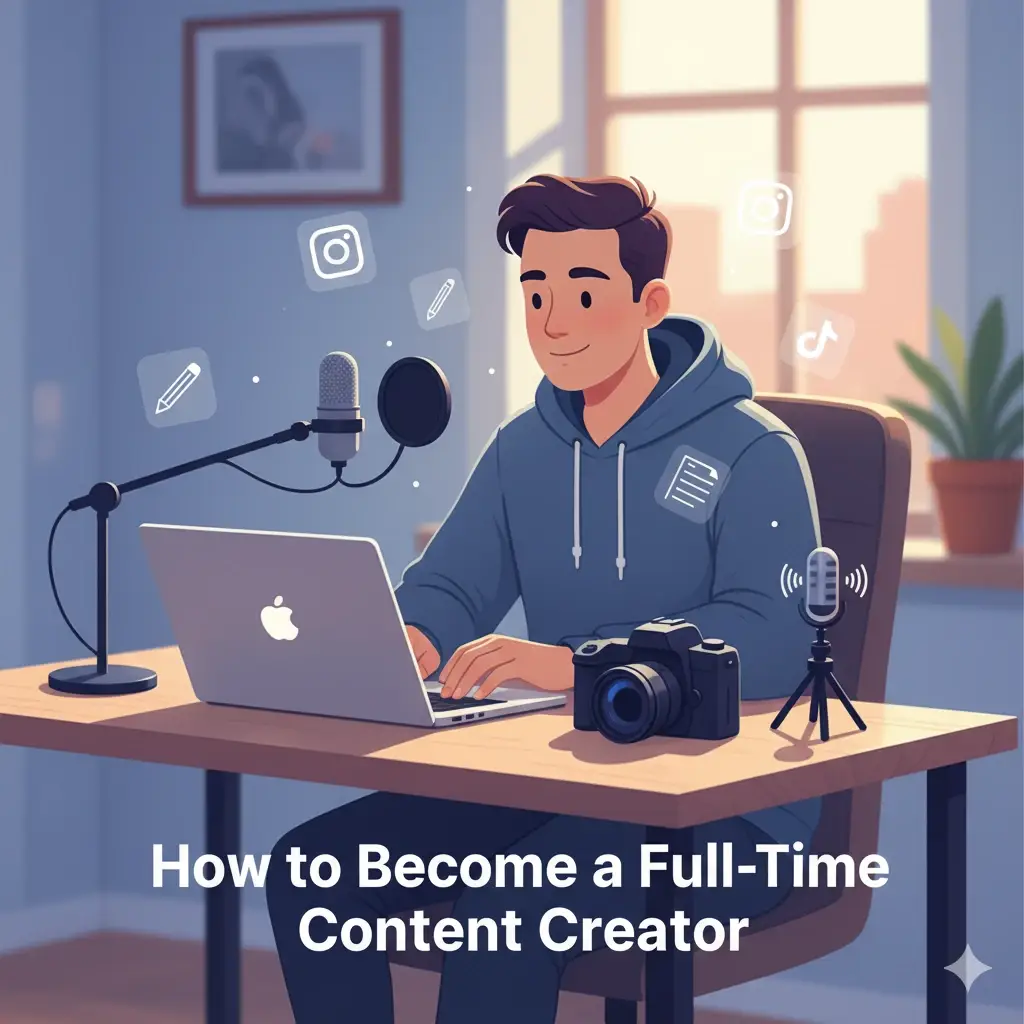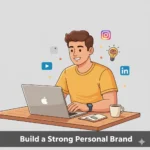A few years ago, if you told someone you wanted to become a “content creator,” most people would either laugh it off or not even understand what you meant. Today, though, content creation is a real career path. People are earning full-time incomes by sharing their knowledge, creativity, and personality online. Some are doing it through YouTube, others on Instagram, TikTok, LinkedIn, newsletters, podcasts—you name it.
But here’s the thing: becoming a full-time content creator isn’t as simple as just making a couple of videos and waiting for the money to roll in. Behind every creator you admire, there’s probably years of consistency, experiments, failed projects, and lots of behind-the-scenes work that most people never see.
If you’re thinking seriously about taking this path, this blog will walk you through what it actually takes, what mistakes to avoid, and what mindset shifts you’ll need along the way.
Why Do You Even Want to Be a Creator?
Before we jump into the “how,” it’s worth asking yourself why. A lot of people get into content creation because it looks glamorous. You see someone traveling, working from home, and making money just by talking into a camera or writing online. It seems easy.
The truth: it’s not easy. It can be fun, rewarding, and fulfilling, but also exhausting, lonely, and unpredictable. If your only motivation is money or fame, you’ll likely burn out quickly.
The creators who last long-term usually do it because they genuinely enjoy sharing ideas, connecting with people, teaching, or entertaining. Of course, money matters (especially if you want to do this full-time), but the passion part is what keeps you going when growth feels slow.
So ask yourself: Why do I want to do this? Is it freedom? Is it expression? Is it building an audience? Once you’re clear on that, the rest of the process becomes easier.
Choosing Your Platform and Niche
You don’t have to be everywhere at once. In fact, trying to do YouTube, TikTok, Instagram, blogging, newsletters, and podcasts all at the same time will just drive you insane. Start small. Pick one or two platforms where your style of content feels natural.
For example:
-
If you love writing and long-form ideas → blogging, Medium, Substack, or LinkedIn might be your lane.
-
If you’re funny, quick, and creative with visuals → TikTok and Reels could be a great fit.
-
If you enjoy teaching or storytelling on camera → YouTube is perfect.
-
If you’re into conversations and deep dives → podcasting makes sense.
Niche is another buzzword people throw around, but it doesn’t mean you have to trap yourself in one box forever. Start with something you know or care about—fitness, gaming, finance, travel, fashion, tech, cooking, personal development, whatever. Your audience should have a reason to come back, and clarity helps. Later, you can expand into other areas as your personality and brand grow.
One mistake beginners make: waiting too long to pick a niche. You’ll never figure it out by just thinking about it. You figure it out by making stuff, seeing what sticks, and adjusting.
The Money Question
Let’s be real—if you want to become a full-time content creator, the financial side matters. The problem is most people only see “sponsorships” or “YouTube AdSense” and assume that’s enough. In reality, you usually need multiple income streams.
Here are some common ones creators rely on:
-
Ad revenue (YouTube, blogs with Google AdSense, etc.) – Not consistent in the beginning.
-
Brand sponsorships – Brands pay you to promote their product. Great, but it usually comes later when you have an audience.
-
Affiliate marketing – You recommend a product/service, and earn a commission if someone buys.
-
Selling your own product/service – Courses, ebooks, coaching, merchandise. This often becomes the main income driver for serious creators.
-
Community/membership – Patreon, paid newsletters, exclusive content.
When you’re starting out, don’t stress too much about monetization right away. Focus first on growing an audience and providing value. But at the same time, keep in mind that your long-term sustainability depends on building systems that eventually generate income.
Consistency > Perfection
This is the part where most people fail. They’ll post a few times, get discouraged when the numbers don’t blow up, and quit. The truth is consistency is more important than perfection.
Think about your favorite creators—they didn’t get there overnight. They probably have hundreds of videos, blog posts, or podcasts under their belt. Most of their early stuff wasn’t great, but they kept going, learned, and improved.
Here’s the harsh reality: your first 50 or 100 pieces of content probably won’t be your best work. And that’s okay. The only way to get better is to make more, not to sit around planning endlessly.
So pick a schedule you can actually maintain. Maybe it’s two YouTube videos a month, three TikToks a week, or one blog post every Sunday. Stick to it for at least 6–12 months before expecting big results.
Building Your Audience
Audience growth is where strategy comes in. Creating is one thing, but getting people to actually see your work is another. A few things that help:
-
Engage, don’t just post. Reply to comments, join communities, collaborate with others. People support people, not just content.
-
Use trends smartly. Jumping on trending topics or sounds can boost reach, but try to add your own twist instead of blindly copying.
-
SEO matters. On YouTube, blogs, or even TikTok, keywords make a difference. Learn basic SEO—it’ll pay off.
-
Cross-promote. Share your YouTube video on Twitter, link your blog in your Instagram bio, mention your podcast in your TikToks. Create little pathways for people to find your other stuff.
-
Email lists. Sounds boring, but owning your audience is important. Social platforms change their rules all the time, but an email list is yours forever.
The main thing: don’t obsess over going viral. Viral moments can help, but long-term creators grow steadily by building trust and showing up consistently.
Mindset Shifts You’ll Need
-
It’s a marathon, not a sprint. Building a full-time career can take years, not weeks.
-
Comparison kills progress. Looking at someone with a million followers when you have 200 is pointless. They’re at a different stage of the journey.
-
You won’t always feel motivated. Discipline beats motivation. Some days you’ll love creating, other days it’ll feel like work. That’s normal.
-
Feedback is a gift—but not all of it is useful. Learn to separate constructive criticism from random hate.
-
Done is better than perfect. You’ll always feel like your work could be improved. Publish it anyway.
Behind the Scenes: The Work No One Talks About
From the outside, it looks like creators just hit record, post, and get paid. The reality? There’s a ton of background work. Things like:
-
Researching ideas
-
Writing scripts or outlines
-
Filming and editing (which can take hours for one short video)
-
Designing thumbnails or graphics
-
Learning algorithms and analytics
-
Negotiating with brands
-
Answering DMs and emails
If you’re not prepared for this kind of workload, it can feel overwhelming. Some creators eventually hire editors, managers, or assistants, but in the beginning, you’ll probably be doing everything yourself. That’s okay—treat it as part of the learning curve.
Dealing With Burnout
This is real. When your passion becomes your job, it’s easy to burn out. You might feel pressure to always post, always grow, always stay relevant. That pressure can kill the joy of creating.
Some ways to protect yourself:
-
Take breaks without guilt. One missed week won’t ruin your career.
-
Batch your content—record or write multiple pieces at once so you’re not always in a rush.
-
Remember why you started. Revisit your original motivation when things feel heavy.
-
Build a life outside of content. Friends, hobbies, offline experiences—they’ll actually make your content better.
Turning Part-Time into Full-Time
At what point do you go all in? There’s no single answer. Some people quit their job early and take the risk, others wait until they’re earning consistent income on the side.
A practical rule of thumb: once your content income matches at least 60–70% of your job income consistently for a few months, you can consider making the switch. That way you’re not panicking about money.
Also, think of your creator career like a business. Track your expenses, reinvest in better equipment or software, and treat your time seriously. The more professional you are, the more opportunities will come.
Final Thoughts
Becoming a full-time content creator is possible. Thousands of people around the world are doing it right now. But it’s not magic. It’s patience, persistence, creativity, and a lot of unseen effort.
If you’re serious about it, start small. Pick your platform. Commit to a schedule. Learn the basics of audience building and monetization. Accept that growth will be slow at first. And keep going when it feels like no one’s watching—because eventually, if you stay consistent, people will.
In the end, it’s not just about making content. It’s about building a life around your creativity, and that takes time.



